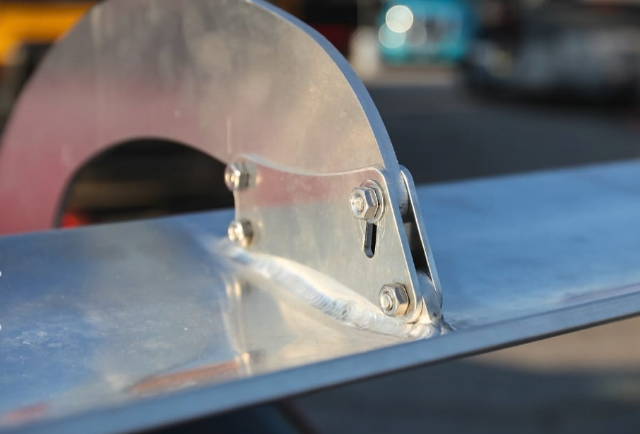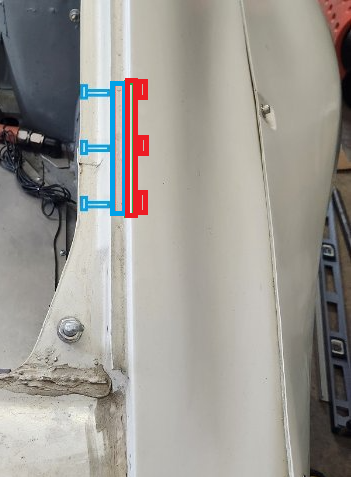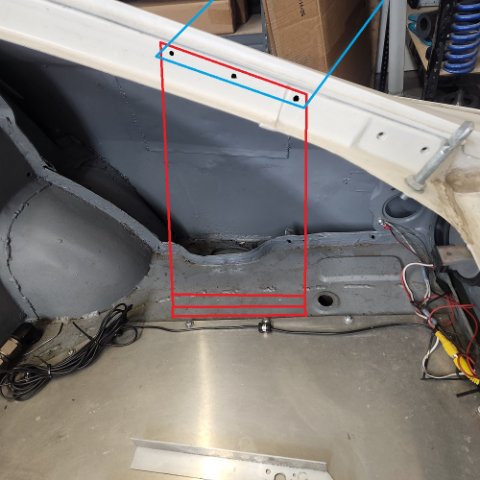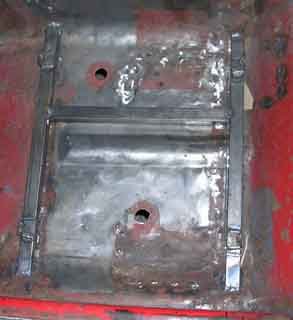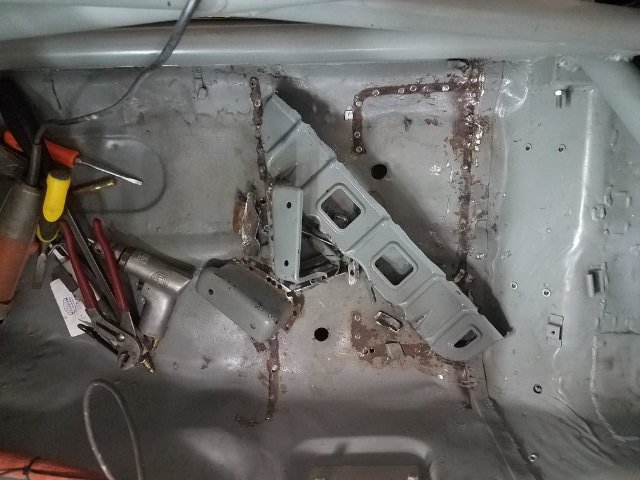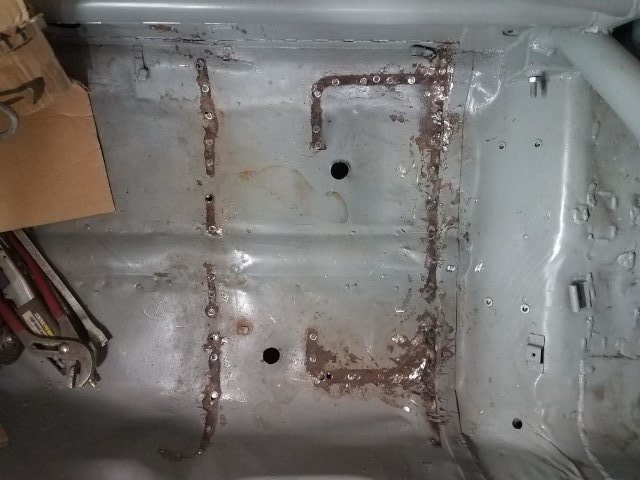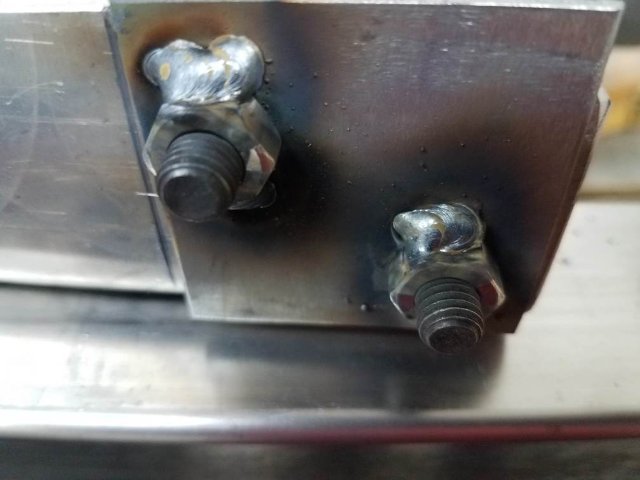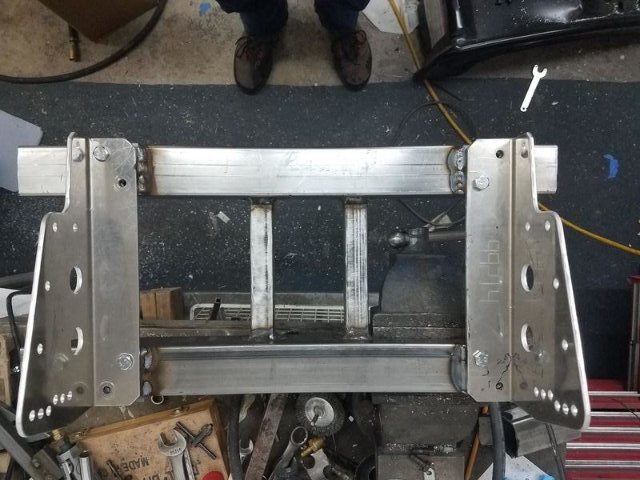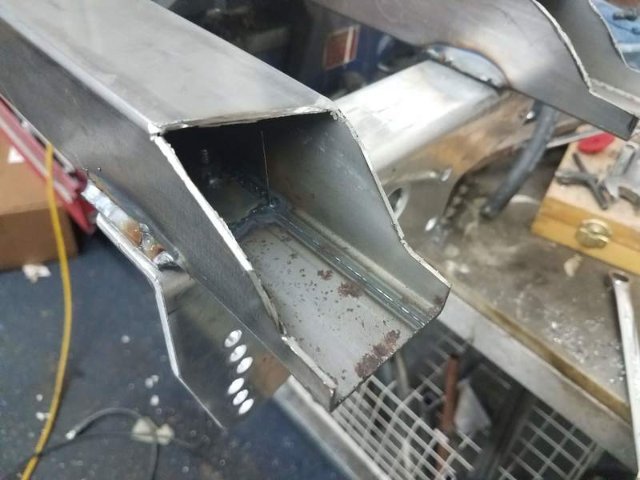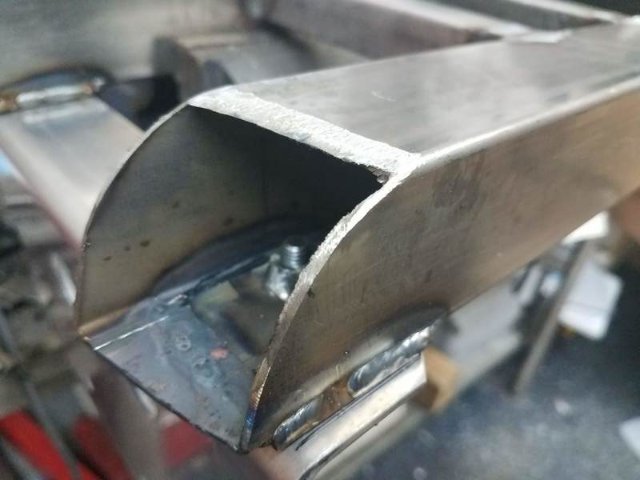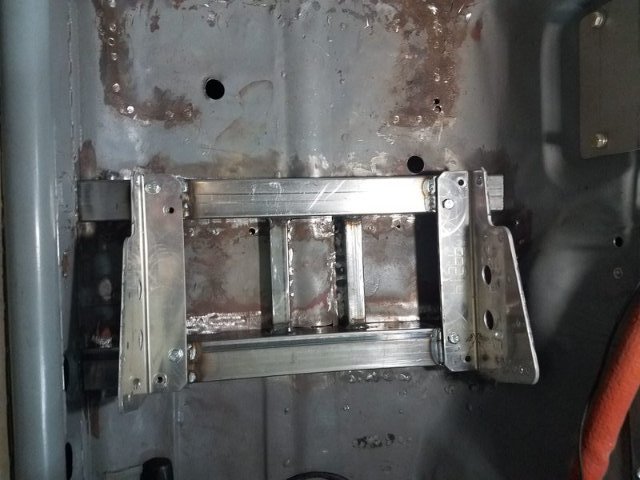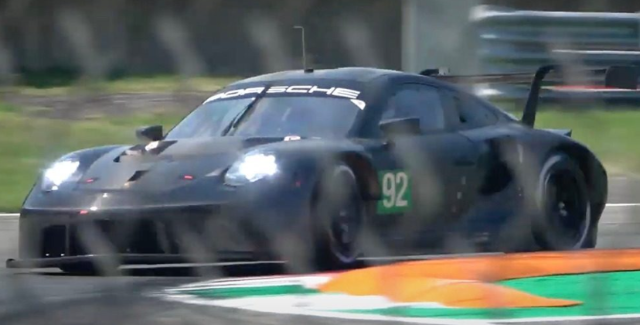-
Posts
13742 -
Joined
-
Last visited
-
Days Won
67
Content Type
Profiles
Forums
Blogs
Events
Gallery
Downloads
Store
Everything posted by JMortensen
-
Does it matter? I was a newbie with 13K posts a while back, now I'm a "Collaborator." I haven't found that my coffee tastes different in the morning. YMMV. EDIT--I expect that your inability to reply was to a FAQ post. Used to be that posts to that forum had to be approved by moderators, the idea was to keep that area easy to search, and use it for useful posts that deal with popular topics. Now anyone can post there and it shows up without approval, but nobody can respond.
-
Chassis mounting wing
JMortensen replied to JMortensen's topic in Windtunnel Test Results and Analysis
Yeah, for sure the hatch area can take hundreds of lbs of force. there is a reinforcing panel underneath the pillar, and it handles slamming the hatch for decades. My wing, as delivered, was supposed to make ~600 lbs of downforce at 150 mph. I'm probably going to make a second element for it, so might be closer to 1000. I think it needs some way to transfer that load to the floor. If you're using a wing like the one they tested in the wind tunnel (small) then yeah, just bolt it on and go. -
Chassis mounting wing
JMortensen replied to JMortensen's topic in Windtunnel Test Results and Analysis
Got a really strong answer on the slippage question, so I thought I'd spread it around: "Its been awhile so I may be missing something. Based on this calculator, its showing that torquing a 1/4-20 bolt to 20in-lb would give a preload of 426 lbs. https://mechanicalc.com/calculators/...orque-preload/ Then going here https://www.engineeringtoolbox.com/f...nts-d_778.html and putting in US units (Slugs) and 32ft/s2 plus 1.35 mu for aluminum I doubled the answer because you have two surfaces sliding against each other in the pictured joint. In reality, you would have 4 because of two sides of the wing. Or only 2 if you did a single-shear joint. So with 2, it should not slide until 1120 lbs is added to it Also, you are sharing load with the front bolt as well. If you slot the rear bolt, if it does slide it will lower the wing angle and reduce the downforce. If you slot the front bolt, it will increase the wing angle and increase the downforce." -
Chassis mounting wing
JMortensen replied to JMortensen's topic in Windtunnel Test Results and Analysis
Now it looks like it's in there twice. -
Chassis mounting wing
JMortensen replied to JMortensen's topic in Windtunnel Test Results and Analysis
I like this because it's double shear and easier to fab. Wouldn't have to line up and drill 20 holes. Thoughts on slippage? -
Chassis mounting wing
JMortensen replied to JMortensen's topic in Windtunnel Test Results and Analysis
Thought was to have two sets of uprights, one SCCA legal and one not, the not legal setting the wing further back. AL is getting pricey, but this is surprisingly cheap. Still need to get some sheet AL to do under the drivetrain. Might do both and then go pick it up in Seattle and save the shipping cost. Forgot link: https://www.onlinemetals.com/en/buy/aluminum/0-25-aluminum-plate-6061-t651/pid/1248 -
Chassis mounting wing
JMortensen replied to JMortensen's topic in Windtunnel Test Results and Analysis
I think we're on the same page there. The bracket to floor will be on the outside of the wing support, so the bolts will go through the sheet metal, the wing support, and the 1/8" plate, and then there will be a nut welded to the back of the plate. Hard to draw this stuff well, and helps if you don't change colors... duh. Should be more like this: -
I picked up an extruded AL wing off of ebay for a surprisingly good price. 65" wing, $379 plus tax. https://www.ebay.com/itm/324563472720 When it shipped it went from FL to WA, then to IL, then back to WA. So it went about 7000 miles to be delivered 3000 miles away. The built in gurney got bent from all the extra traveling, but only a couple inches in from the end and I think I can probably straighten some of it. I talked to the seller and I took a discount and I'll chop the end off. I think I can make it a 63 or 64 inch wing and make that work. They suggested a miter saw, which I have, so shouldn't be too big a deal to cut it (hoping). Actually just looked at it again, now thinking of hacking off the gurney instead and keeping the full width... Looking at how to do chassis mount. Years ago I had talked to Cary and he had suggested a 1/8" aluminum plate from the hatch to the floor to take the vertical load. I still have the piece that I bought years ago. Thinking I can screw to the hatch area at the top, and just run the plate straight down to a piece of angle aluminum, and then bolt that straight to the frame rails with nutserts. The problem is where it hits the car. There is a natural angle where the outer weatherstrip goes, then a step down to another angle where the main hatch weather strip goes. I can't put the upright on the first ledge. There isn't enough room for a decent sized fastener in there. If I put it down a step, then the upright takes up too much space and I'd have to really hack into my fiberglass hatch to get it on. I think the solution is to cut a slot in the first step and slide the uprights down into the chassis and then bolt through. There is a doubled up piece of metal in the hatch there which will make it harder to get to the back side of the 1/8" sheet. Think I'll weld nuts to the aluminum to solve that problem. Going to trace the wing profile onto a piece of cardboard and start playing with uprights. Plan is 1/4" 6061 for the uprights from the body to the wing. I could probably cut holes to lighten it from there, but I'm not going to worry about it right now. More fixated on getting it installed on the car. Thoughts and feedback appreciated.
-
Apparently youtube shorts are not just short youtube videos that go to your own channel. Oops. I put a couple of videos on my diff pump fail on there, and apparently they're out there getting viewed by people who want TikTok kinds of videos. Now one has several hundred views and 7 likes. LOL. EDIT--Good news is the guy who sold me the bad pump agreed to refund me, so at least I didn't lose that money. EDIT 2--Found another seller with a better looking pump, and a seller with a rebuild kit for these pumps. So I bought the pump and the rebuild kit, hopefully this one is in good shape and it will get fresh bearings and be ready to go before installation.
-
Pulled the diff oil pump out and decided to start on a mount. Immediately noticed a ton of play in the shaft. Not many parts in there, so I took it apart. Wasted. I guess I'll have to get another pump. Oh, and my wing looks like UPS lost it. FML.
-
Easy to do. Don't know why I had any hesitation. Vent popped right out with screwdriver. 1/2" drill bit, then 9/16, then tap. The hole is pretty close to the edge so I tried to work the drill away from the edge when I drilled the holes. No problem.
-
Just cleaning up the diff cover so I can weld a drain to feed the pump, and looking at the plastic vent. Might be a good time to upgrade that. Never pulled one out before, looks like you can just lever the plastic vent out of the cover. After that seems like there is enough meat there to drill out the hole to 1/4NPT, then run a fitting off of that and attach to a catch can positioned somewhere convenient. Anything else to know?
-
Well, you post something and then look afterwards, and this is what you get. Whole kit, less the side shims. $365. Note that it says same for 280Z, ZX and 300ZX: https://zcardepot.com/collections/rear-axle-and-differential/products/r200-differential-rebuild-bearing-seal-kit-280z-280zx-300zx
-
I don't think anyone sells a kit. The ball bearing at the front is Nissan only last I checked. The pinion and carrier bearings might be something you can source elsewhere, but I only bought factory. I just bought pinion and side seals for my diff from www.zcardepot.com. Pinion seal was factory, sides were in a Timken box. There is a difference in the early and later pinion bearings. I couldn't tell you part numbers, but IIRC the tapered roller pinion bearings in the later years were larger. Ball bearing was the same. I think all the carrier bearings are the same too, but probably best to pull them and order by the part number. Shouldn't need to reshim anything if you do change the bearings, but if you do need to adjust backlash because you're adding an aftermarket LSD for example, Jay Zinc (on FB, not sure if he's a member here) sells a carrier bearing shim kit. I would suggest that if your diff isn't making noise, or if the bearings don't look worn it's probably not worth it. You'll spend $500 or $600 (more?) on parts and it won't make the car any faster. These diffs run hot so they might be damaged if they were raced, but if it's out of a street car they rarely go bad.
-
Greg Ira returning to SCCA Run-Off's for another title bout!
JMortensen replied to AydinZ71's topic in Announcements
Good luck, Greg! -
Still trying to figure out what material to go with for the panels on the bottom. The more I think about it the more I think I might want to drop the floor down an inch or so in the back. The car has a pretty good rake to it and the splitter was 2.5" off the ground in front, but I think the rear of the frame rails might be more like 4 or 4.5" up off the ground. Dropping it down I could make the diffuser longer and move the CP forward. Was settled on 10mm Alumalite for the undertray and then Alumanate for the diffuser. Alumanate is flexible, which is why I'd want to use it on the diffuser, but then started trying to figure out side splitters. First thought was to put an angle aluminum frame around the perimeter of the side boards, then lay the alumalite into it. Then I got to thinking of people stepping on them getting in/out. I don't think the Alumalite is strong enough to be walked on, but have no experience with it, maybe I'm wrong on that. I got to thinking what if I used Alumanate everywhere, and made either a .5" square aluminum tube frame and used 6mm Alumanate on top and bottom or .75" aluminum tube frame with 3mm Alumanate. That would definitely provide the stiffness needed to walk on the thing and the aluminum tubing is really light. I want to make it so that all the undertray parts except the center section between the frame rails are able to be taken on and off in a matter of seconds. Center section will screw on. Following AJ Hartman's videos, I'm going to do a square tube receptacle welded to the frame of the car, front back and sides where the splitter and side boards and diffuser plugs into, and then have cotter pins on brackets around the frames to support them vertically. I'm also going to redo my splitter mount. I'm keeping the part that tube80z suggested where the splitter is hung on 2 pivots that are able to be raised and lowered into the frame, but I'm going to build a steel tube frame and have it go out to the sides - currently splitter mounts only near the middle and with splitter rods in the front. I'll attach the steel frame to the chassis similar to the way AJ does, and then probably ditch the splitter rods. I don't think the rods are necessary and they require tools to remove.
-
Flipping cages shouldn't be necessary with the Silvermine adapters. If you go to put them in and can compress the CV enough to fit it in the car with the suspension fully drooped (where the CVs need to be shortest), then don't worry about flipping cages. If you can't compress enough, then you can get into all that BS. It doesn't gain you much, really need to flip and then grind the axle down for clearance. But you shouldn't have to do any of that.
-
FYI, the shaft size on the motor is not 5/16, it's 8mm. About .015 difference, but it's enough that the adapter won't fit. I've got an 8mm drill bit coming, seems like the quickest fix. 2 of the 5 manometers have shown up. They're pretty heavy. Looking like I will have gauges all the way across the pass side of the dash.
-
Removing cross support/seat mounts on floor pan
JMortensen replied to seattlejerry's topic in Interior
Thought I had more pics of the driver's side. The longitudinal bars are welded to the frame rails. The rest is stitched to the floor. -
Removing cross support/seat mounts on floor pan
JMortensen replied to seattlejerry's topic in Interior
2 ideas for you: 1. Cut foam out of the seat. This is going to be A LOT easier than modifying the mount. I did the same on my Miata to get clearance for a helmet. Just have to pull the cover off the bottom, cut with an electric carving knife, and reassemble. The seat cover will probably be loose after. 2. Remove the original seat mounts and make shorter ones. I have done this to install aluminum race seats on my 240. The 240 has a significantly different floor pan, and I'm not familiar enough with the 280 to give specific advice, but here are some pics of what I did to my 240. I did 1" tube on the driver's side, and 2" tube on the pass side. -
Well, this is all snowballing. Still waiting on my electric motor to arrive. I did go ahead and buy the adapter for the shafts so I didn't have to wait even longer for that. Have all of my plumbing fittings for the diff cooler, pushlok hose arrived today. Have to drill another hole for the oil return and weld a bung to the diff cover for to feed the cooler. I found an old thread of Coffey's on another site where he talked about welding fittings to the cover, so I'm confident that it can be done. I can probably weld it myself, even though my tig work is shit. Doesn't really matter what it looks like, as long as it doesn't leak. Nobody is going to see it. Bought 5 cheap used 1" magnehelic gauges off of ebay and a pitot tube. $75 min order from the mfr of the little puck things, so I bought 8 of them. Figure if I'm going to do it, might as well set them up in different areas and that way I can test a bunch of stuff at the same time, and not have to do 1000 runs, seeing as how my car isn't street legal. Should have about $300 into it by the time I can set it up and test. Gauges were between $15 and $25 each. Thinking I can grid out spots to test on the car and then do a track day and just change the position between sessions or even just pull in to the pits and change positions and go back out, and just pick a comfortable rpm to run down the front straight (no speedo) and set up a camera to watch the gauges. Do 1 or 2 runs to test pressures, and then enjoy the rest of the session. Probably have to extrapolate a lot of info, but seems like should be able to get a pretty decent idea of what is going on. Little concerned about how to hook up 5 manometers to the one pitot tube. Edgar had a video where he attached the pitot to an aluminum bottle, for all intents and purposes, and then measured off of that. I watched a couple days ago. Should have bookmarked. Thinking might be able to do that and then run 5 taps out to the manometers. Just not sure that I can run 5 manometers with tees off of the 1mm tube alone. That seems like a problem. Thinking of making a removable dashboard for them that hooks to the cage so I don't have to set it up every time, and pitot bracket that attaches to the cage near the window, so it can be bolted and unbolted easily. Also really want to get a cheap wing to put on the car. It has a lot of tricks on the front and I feel like it is probably going to need something to balance it out. This one I found looks similar to the 9 lives racing setup at a fraction of the cost, just have to make uprights and have the mounts welded to the wing (will pay someone to weld this part, if the wing comes off it's a big problem). 65" width, chord is 9 3/4, profile looks reasonable. Has a built in gurney, could stick a bigger one in front of it if necessary. Then I can work towards a better one later on. later. https://www.ebay.com/itm/324563472720
-
If anyone wants to buy some of those pressure patches, I'll have 3 extras. Diff sold, so I'm spending some money.
-
Think I figured out my question about where to test pressures. You can test before and after a radiator because that's where the air flow is different and affects flow through the radiator. On the diffuser it's affecting the airflow over the car vs underneath. Pressure on top of the diffuser or in the cabin is irrelevant because it should be the same on top and bottom, so it's pushing as much up on the floor as it is down and whatever effect is that has is negated.
-
This looks like the video to watch for measuring devices. I am a bit confused by the pitot tube vs the puck measurement. I had thought that if the aerodynamic forces were working on a specific part eg a diffuser since that's the focus of the thread that you would want to test pressure on top of the diffuser and on bottom, not the bottom vs a pitot tube way up higher than the car. I'm questioning the need to have that huge stand on the hood too. Porsche's looks more modest:


